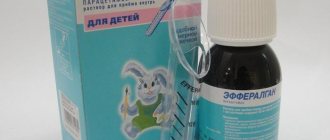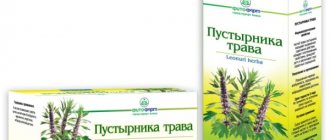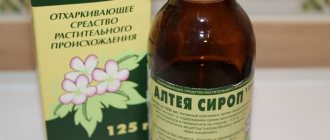Pharmacological properties of the drug Paracetamol for children
Paracetamol (N-(4-hydroxyphenyl)acetamide) has analgesic, antipyretic and weak anti-inflammatory effects. The mechanism of action is associated with inhibition of prostaglandin synthesis and an effect on the thermoregulation center in the hypothalamus. After oral administration, paracetamol is rapidly absorbed into the gastrointestinal tract, mainly in the small intestine, mainly by passive transport. After a single dose of 500 mg, the maximum concentration in the blood plasma is reached after 10–60 minutes and is about 6 mcg/ml, then gradually decreases and after 6 hours it is 11–12 mcg/ml. It is well distributed in tissues and mainly in body fluids, with the exception of adipose tissue and cerebrospinal fluid. Plasma protein binding is less than 10% and increases slightly with increasing dose. Sulfate and glucuronide metabolites do not bind to plasma proteins even in relatively high concentrations. Paracetamol is metabolized primarily in the liver by conjugation with glucuronides, conjugation with sulfate and oxidation with the participation of mixed liver oxidases and cytochrome P450. The negative hydroxylated metabolite N-acetyl-p-benzoquinoneimine, which is formed in very small quantities in the liver and kidneys by mixed oxidases and is usually detoxified by binding to glutathione, can accumulate during paracetamol overdose and cause tissue damage. In adults, most of paracetamol is bound to glucuronic acid and in smaller quantities to sulfuric acid. These conjugated metabolites do not have biological activity. In premature infants, newborns and in the first year of life, the sulfate metabolite predominates. The half-life is 1–3 hours. In patients with liver cirrhosis, the half-life is slightly longer. The renal clearance of paracetamol is 5%. The drug is excreted in the urine mainly in the form of glucuronide and sulfate conjugates. Less than 5% is excreted as unchanged paracetamol.
Instructions for use
Is it possible to give Paracetamol to children? It is possible, but it should be noted that if a patient of five or six years cannot swallow a tablet whole, it must be divided into parts or crushed into powder. It is impossible to give the drug in tablet form to an infant, so it is better to resort to rectal suppositories.
Paracetamol 200 milligrams is very popular. The tablets are instantly absorbed by the body, so after only half an hour a positive effect occurs from taking them. In addition, the tablets do not contain unnecessary impurities that could harm the child when using the drug orally.
You can not only bring down the temperature with medicine, but also eliminate pain from migraines, as well as neuralgia and osteochondrosis. How to eliminate fever with Paracetamol:
- Children under two or three years old should not be given antipyretic tablets. But, if the doctor has prescribed the use of a medicine for a child in this form, then you can resort to such therapy.
- It is recommended that young patients under the age of five or six years be given the drug in tablet form, but only in a dose of 100 milligrams. The medication can be given to a child at this age no more than twice a day.
- Children under 12 years of age are prescribed Paracetamol in a concentration of 200 milligrams. The dosage of the medication depends primarily on body weight, so before giving it to the patient, you need to read the instructions.
- Adolescents over 12 years of age are prescribed the drug at a concentration of 500 milligrams.
The instructions for use indicate that children under 12 years of age can be given Paracetamol with a concentration of the active substance of 500 milligrams, but the dosage must be calculated correctly. It is important to note that before giving the drug to a child with a high fever, you should consult a medical specialist. The doctor will tell you how to use the medication, how much Paracetamol you need, as well as the frequency of use.
It is worth noting that a child’s temperature needs to be corrected in a situation where the thermometer shows more than thirty-eight degrees. An adult patient can begin to eliminate the fever if the temperature is at around 38.5.
Use of Paracetamol for children
The drug is prescribed orally. Single dose for children aged 6 months to 1 year - 60-120 mg (1/2-1 teaspoon of syrup), from 1 year to 3 years - 120-180 mg (1-1.5 teaspoon of syrup), from 3 to 6 years - 180-240 mg of paracetamol (1.5-2 teaspoons of syrup), from 6 to 12 years - 240-360 mg of paracetamol (2-3 teaspoons of syrup), over 12 years - 360-600 mg paracetamol (3–5 teaspoons of syrup). The frequency of administration is 3-4 times a day with an interval between each dose of at least 4 hours. The maximum duration of treatment is 3 days.
Is Paracetamol allowed for children aged 2 years?
According to the instructions for use, it is known that the drug can be given to a child of this age and older. But it should be noted that at two or three years old it is preferable to give syrup to a small patient, and before two years it is best to use rectal suppositories.
Children with fever can take the drug in tablet form, but the drug must first be crushed and then given to the child with water.
It must be remembered that at elevated temperatures, the child can be given the drug no more than four times a day. The time interval between uses should be four to six hours. The duration of treatment should not exceed three days.
Whether a child can be given Paracetamol for fever depends on age and body weight. If a small patient has a fever, the medication should be calculated based on the following dosage: per kilogram of the child’s weight, 10 milligrams of an antipyretic drug will be required.
For a baby whose body weight is 10 kilograms, 100 milligrams of medication will be required. It is important to know that the medicine helps bring down a child’s fever thirty minutes after use.
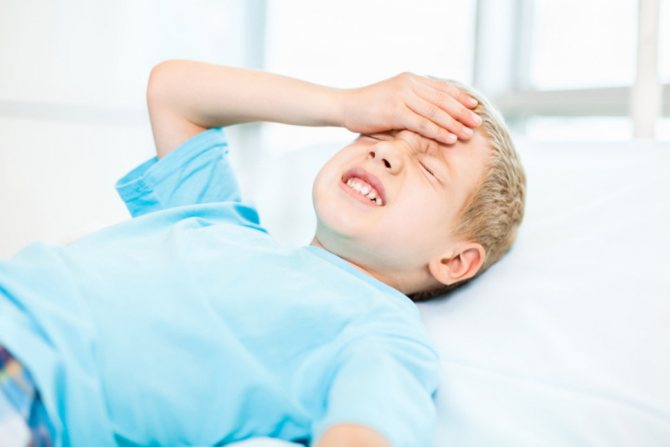
Special instructions for the use of Paracetamol for children
Use with caution to treat patients with impaired liver and kidney function, with benign hyperbilirubinemia. Long-term use of anticonvulsants causes an increase in the activity of liver enzymes, which increases the intensity of the effect of primary passage through the liver and increases the clearance of the drug. This may prevent paracetamol blood levels from reaching therapeutic levels. With long-term use of the drug, monitoring of the peripheral blood picture and the functional state of the liver is necessary.
Release form
“Paracetamol” for fever is produced in three dosage forms:
- pills;
- syrup;
- rectal suppositories.
All of these types of medication are designed to reduce high fever. It is necessary to give a child paracetamol in certain forms depending on his age.
The main advantage of the drug in tablet form is its low price, especially when compared with syrups. Most parents resort to tablets only when the child is five years old. It is at this age that a child can swallow Paracetamol tablets so that it does not get stuck in the throat. Some mothers are in no hurry to give their baby medication in this form and use it only from the age of six.
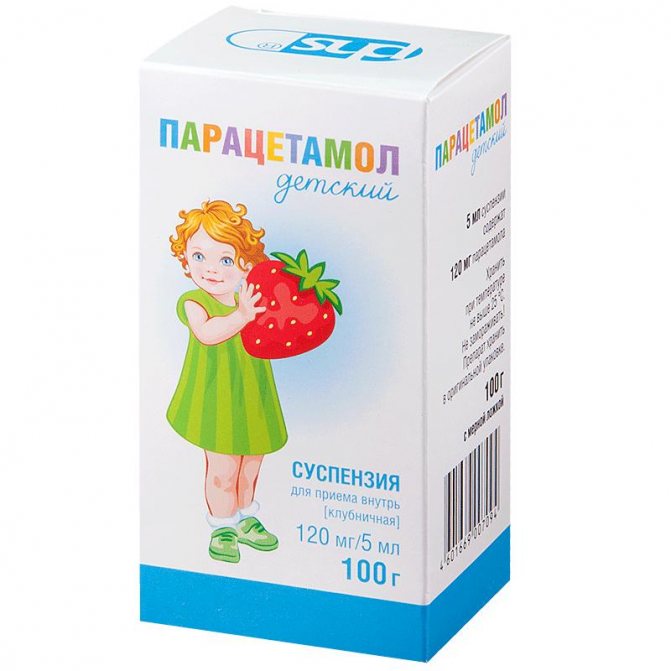
When to give paracetamol to children? What effect does it have?
You are here: Home > Questions and answers > Questions about children > Questions about children's health
May 18, 2014 | views: 3,234
A small child still has a very weak immune system. And suddenly the mother notices that the baby has a fever and is crying. What antipyretic drug should I give him?
Children's paracetamol is prescribed for high body temperature and as an analgesic (including headaches, migraines, toothaches, myalgia, injuries and burns). It is also used to eliminate febrile conditions during infectious and inflammatory diseases.
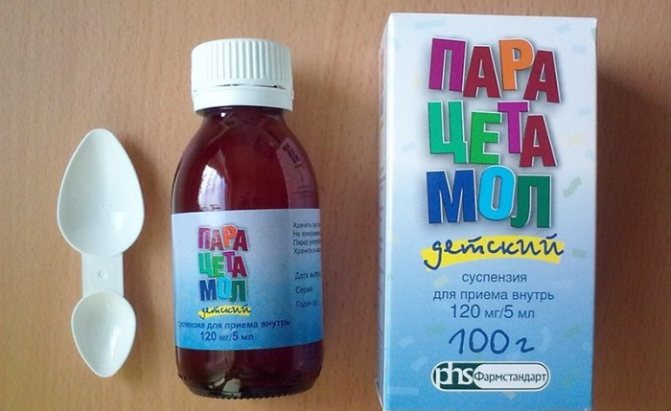
The anti-inflammatory effect of children's paracetamol is weak. It must be remembered that pain and fever are indicators that some kind of inflammatory processes are occurring in the body, and the body is trying to suppress them itself. Therefore, children's paracetamol only relieves the symptoms of the disease, but does not cure it in any way. If the temperature has risen slightly, then the use of children's paracetamol can only prevent the child's body from coping with the microorganisms that caused the inflammatory process. Giving a child paracetamol in such a situation can only cause harm.
When is the use of children's paracetamol not only justified, but also necessary? In cases where the temperature becomes very high, measures must be taken to bring it down. A fever that is too high can be dangerous for a child, especially if he or she is under three years old, because a high temperature can cause seizures. If the temperature is above 39 degrees, you need to urgently take the necessary measures, give the child an antipyretic drug - children's paracetamol.
This drug is good because it is quite harmless to the child’s body and acts almost instantly. Within half an hour you can notice the effect of taking paracetamol, the effect of which lasts for four hours. One of its advantages can also be noted that it can be combined with other anti-influenza drugs and rarely causes side effects.
The form of release of the drug is varied: there is children's paracetamol in the form of tablets or capsules, suppositories, powder and syrup. You can buy it at any pharmacy.
What rules should you remember when taking paracetamol for children? The most important thing is that the doctor prescribes the drug and determines the dose needed for your child. The maximum daily dose is 60 mg per kilogram of the child’s weight.
It should be taken within 3-5 days before meals and no earlier than 4 hours after the previous dose.
Paracetamol is contraindicated in a child if he has kidney or liver disease, metabolic disorders, or is allergic to paracetamol. The maximum effect of the drug occurs during colds or infectious diseases. If the temperature does not decrease, and the child only gets worse, he may have a more complex disease, and he should be immediately shown to a doctor who will prescribe him another medicine.
Leave your comment: Cancel
Pharmacological action and indications for use
High temperature in children is dangerous for the development of complications of the infectious-inflammatory process and the occurrence of seizures. Paracetamol reduces pain and reduces temperature due to its effect on the functions of the corresponding nerve centers.
Indications:
- Pain of mild to moderate intensity in the throat, ears, headache, joint, muscle, dental (including teething).
- Feverish state in diseases of infectious origin.
- Increase in temperature after vaccination.
- Pain due to burn or injury.
- Fever of unknown etiology.
- Neuralgia.
Medical experts recommend using paracetamol, ibuprofen or combination drugs containing these active ingredients to get rid of feverish syndrome. The medications are antipyretics, non-narcotic analgesics. Paracetamol belongs to the anilides, ibuprofen belongs to the group of non-steroidal anti-inflammatory drugs (NSAIDs). The effect of paracetamol on the area of inflammation is much weaker than that of ibuprofen and other NSAIDs. However, acetaminophen is less irritating to the gastrointestinal mucosa.

